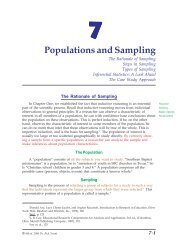- Page 5 and 6: forewordCopyright © 2009 by M.E. S
- Page 8 and 9: forewordForewordWith each year that
- Page 10: forewordIn addition to the alphabet
- Page 15: introductionthe limits of a compact
- Page 19 and 20: aberrant readingaberrant reading in
- Page 21 and 22: Academy ratioers, and technical art
- Page 23 and 24: Acta diurnaActa diurna (Acta public
- Page 25 and 26: added valueadded value extra or add
- Page 27 and 28: advertiseradvertiser manufacturer,
- Page 29 and 30: aerial advertisingreceiving electro
- Page 31 and 32: aided recallof how to use advertisi
- Page 33 and 34: alphanumericeach letter in the syst
- Page 35 and 36: aT&Tated as ASCII] standardized way
- Page 37 and 38: animal communicationanimal communic
- Page 39 and 40: antinarrativeantinarrative [see ant
- Page 41 and 42: arbitronArbitron provider of radio
- Page 43 and 44: articulationarticulation 1. process
- Page 45 and 46: attention model of mass communicati
- Page 47 and 48: audiophileproblems. Audiologists al
- Page 49 and 50: B movie [also called Bpicture] 1. m
- Page 51 and 52: anner exchangein Europe in the late
- Page 53 and 54: eamvideo camera, designed to provid
- Page 55 and 56: Bezos, Jeffrey PrestonAustria) who
- Page 57 and 58: iodatadangerous because of the tend
- Page 59 and 60: lockbuster mentalitymovies came pac
- Page 61 and 62:
oomerang responseboomerang response
- Page 63 and 64:
British invasion1922 in the United
- Page 65 and 66:
Bundlingbundling any transmission s
- Page 67 and 68:
callbackcallback 1. practice of int
- Page 69 and 70:
canonincluding television commercia
- Page 71 and 72:
cascading style sheetfilms intended
- Page 73 and 74:
censorwarecensorware term used to d
- Page 75 and 76:
children’s moviesChomsky, Noam (1
- Page 77 and 78:
citizen journalism(newspaper, magaz
- Page 79 and 80:
cluster groupcluster group group of
- Page 81 and 82:
colonialismassociation with other w
- Page 83 and 84:
coming-of-age moviedaily strip, by
- Page 86 and 87:
complicity of userscommunisuasion c
- Page 88 and 89:
confidence limitsshare common resou
- Page 90 and 91:
consumer sovereigntynot contradict
- Page 92 and 93:
convergencegallery, and given a tit
- Page 94 and 95:
counterculturecore audience percent
- Page 96 and 97:
cross-media ownership(camerapersons
- Page 98 and 99:
culture jammerscultivation differen
- Page 100 and 101:
cyborgcyberfeminism study of the ef
- Page 102 and 103:
Davis, Angeladata analysis compilat
- Page 104 and 105:
definitiontext that guides its rece
- Page 106 and 107:
dmafashioned). In advertising analy
- Page 108 and 109:
dial-up accessdeviance behavior tha
- Page 110 and 111:
digital music distribution platform
- Page 112 and 113:
drtvcrucial questions about authors
- Page 114 and 115:
displacementto describe how languag
- Page 116 and 117:
doo-wopin a factual manner, includi
- Page 118 and 119:
drive-time audienceslife story, usu
- Page 120 and 121:
ear box in the top corner ofthe fro
- Page 122 and 123:
Electronic Frontier Foundationand p
- Page 124 and 125:
emergent cultureelectronic smog ele
- Page 126 and 127:
enlargementand worldview of the cul
- Page 128 and 129:
e-publishingand the Odyssey by Home
- Page 130 and 131:
expressionevent television televisi
- Page 132 and 133:
fable story designed toimpart a mor
- Page 134 and 135:
fast motionfan fiction fictional st
- Page 136 and 137:
feminist theorypicture director. Fe
- Page 138 and 139:
Fiske, Johnally took place in large
- Page 140 and 141:
footnoteciplines, which is designed
- Page 142 and 143:
framingFourth Estate a synonym for
- Page 144 and 145:
ftpfreelance writer, journalist, or
- Page 146 and 147:
gag joke or comic skit toldor acted
- Page 148 and 149:
gesturegenre category or classifica
- Page 150 and 151:
Goffman, Ervingmunication and media
- Page 152 and 153:
graffitiA Goth at the Wave Gothic F
- Page 154 and 155:
gross rating pointa computer user t
- Page 156 and 157:
Habermas, Jürgen (1929-)German phi
- Page 158 and 159:
heavy viewerof television have beco
- Page 160 and 161:
hidden-fear appealwho claimed that
- Page 162 and 163:
history technique in advertisinghi-
- Page 164 and 165:
human interestAdorno, is a widely q
- Page 166 and 167:
hypothesistual reality. The term is
- Page 168 and 169:
illuminated manuscriptsidentificati
- Page 170 and 171:
impressionismImpression, Sunrise (1
- Page 172 and 173:
information processing modelexample
- Page 174 and 175:
imaired after a popular program; th
- Page 176 and 177:
internetintercutting going back and
- Page 178 and 179:
intranetinterpersonal communication
- Page 180 and 181:
Jakobson, Roman (1896-1982) Moscow-
- Page 182 and 183:
junk mailJung, Carl Gustav (1875-19
- Page 184 and 185:
Kuleshov effectKISS [full form: kee
- Page 186 and 187:
late nightvocal sounds are not mean
- Page 188 and 189:
lexiconpass into the mainstream of
- Page 190 and 191:
linguistic relativity hypothesisBox
- Page 192 and 193:
lobbyingliteral 1. following the ex
- Page 194 and 195:
Lumière brotherslogograph symbol f
- Page 196 and 197:
macaronic any statementor text char
- Page 198 and 199:
manufacturing consentand nonmale pe
- Page 200 and 201:
marketingthe impression, by extensi
- Page 202 and 203:
mass culturebest-known Marxist theo
- Page 204 and 205:
McDonaldizationmass society in cult
- Page 206 and 207:
meaning theoriesMcNelly’s model o
- Page 208 and 209:
media planmedia control any mechani
- Page 210 and 211:
messagemega-agencies in the adverti
- Page 212 and 213:
micropaymentcognitive. Today, Arist
- Page 214 and 215:
mixingsimplest forms are used, ofte
- Page 216 and 217:
motion picturemontage 1. composite
- Page 218 and 219:
multimediafeature is designed to ge
- Page 220 and 221:
MySpacement investigating various g
- Page 222 and 223:
naming identifying aperson (in rela
- Page 224 and 225:
needs theoryThe most well-known nat
- Page 226 and 227:
networkingNet imperative the idea t
- Page 228 and 229:
newspaperreporting features, and th
- Page 230 and 231:
nostalgiaNipkow, Paul (1860-1940) G
- Page 232 and 233:
O&O’s [full form: ownedand operat
- Page 234 and 235:
oppositionopera theatrical play wit
- Page 236 and 237:
oxymoronotherness [synonym of alter
- Page 238 and 239:
pamphletPetroglyphs on a rock in Ca
- Page 240 and 241:
parallel broadcastdime novels becau
- Page 242 and 243:
PDAexpression through a blend of bo
- Page 244 and 245:
perspectivehe is doing. The term co
- Page 246 and 247:
photographic truthmulaic forms of s
- Page 248 and 249:
podcastingpirate radio radio statio
- Page 250 and 251:
pop languageAndy Warhol’s silkscr
- Page 252 and 253:
post-broadcast mediaof blatant sexu
- Page 254 and 255:
PRESSbecoming the moniker for a mor
- Page 256 and 257:
PROGRAMinstance, by presses to repr
- Page 258 and 259:
PBSor prototypical concept; and Sia
- Page 260 and 261:
Q & A [full form: questionsand answ
- Page 262 and 263:
Radway, Janiceing permanently with
- Page 264 and 265:
REALISmhas no use on broadcasting W
- Page 266 and 267:
REGGAErecord 1. an account or histo
- Page 268 and 269:
RERELEASEreport account of news pre
- Page 270 and 271:
RITUALused in advertising and filmm
- Page 272 and 273:
ule of thirdsJohnny Cash began thei
- Page 274 and 275:
safe harbor broadcasttimes, usually
- Page 276 and 277:
science fictionegy has performed wi
- Page 278 and 279:
secondary viewingscreenplay script
- Page 280 and 281:
senderin which they are reared have
- Page 282 and 283:
Shannon, Claudeexample, TV police d
- Page 284 and 285:
sidebarshooting actual filming of a
- Page 286 and 287:
situation comedymuch of its length,
- Page 288 and 289:
soft-coresnob-appeal technique adve
- Page 290 and 291:
spin doctor1960s and 1970s. The mos
- Page 292 and 293:
storystar system publicity strategy
- Page 294 and 295:
suggestionthe 1800s by means of hyp
- Page 296 and 297:
synesthesiaSurrealism twentieth-cen
- Page 298 and 299:
tabloid small formatnewspaper that
- Page 300 and 301:
telegramtechnological determinism i
- Page 302 and 303:
test screeningteletext service prov
- Page 304 and 305:
theater testingof entertainment; 2.
- Page 306 and 307:
tracking study(1995) and Globalizat
- Page 308 and 309:
two-step flow theorytransmission se
- Page 310 and 311:
UHF [see ultrahighfrequency]ultrahi
- Page 312 and 313:
validity effect theory thatpeople t
- Page 314 and 315:
videodisctape, a DVD); 2. a videota
- Page 316 and 317:
vrexecuting the virus’s instructi
- Page 318 and 319:
webcastTypical Web pageWeb page a c
- Page 320 and 321:
Williams, Raymondpeople of European
- Page 322 and 323:
wwwword painting technique used int
- Page 324 and 325:
Yahoo! American Internetservice pro
- Page 326:
Zworykin, last item Vladimirphysica
- Page 329 and 330:
chronology1790 First U.S. copyright
- Page 331 and 332:
chronology1917 The Pulitzer Prize i
- Page 333 and 334:
chronologyexperimental radio statio
- Page 335 and 336:
chronology1910s Silent films become
- Page 337 and 338:
chronology“family hour” format
- Page 339 and 340:
chronology1984 Apple Macintosh is t
- Page 341 and 342:
ibliographyMedia EffectsBerger, Art
- Page 343 and 344:
328
- Page 345 and 346:
Resources on the World Wide WebMars
- Page 347 and 348:
Resources on the World Wide Web332






